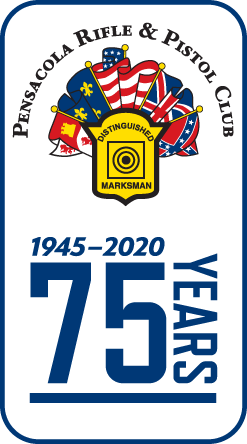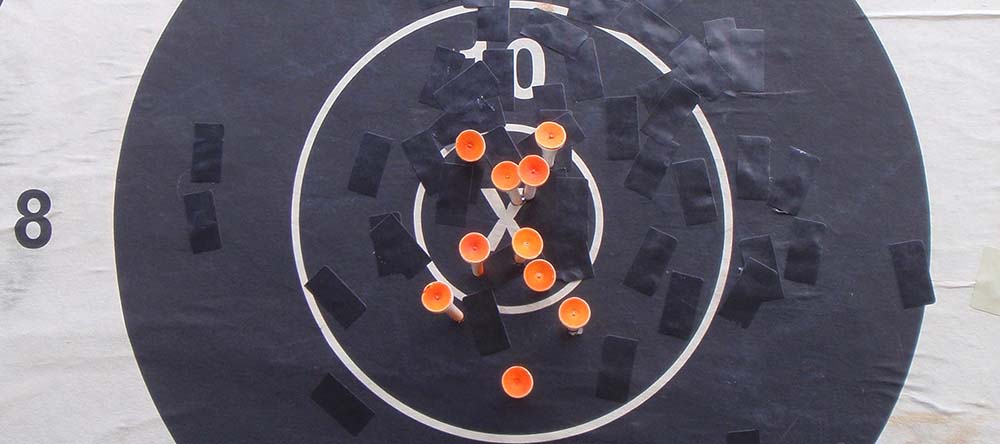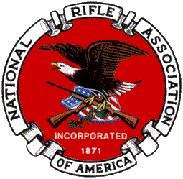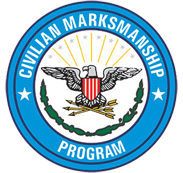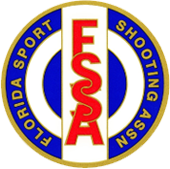High Power Rifle Resources
The NRA High Power Rifle Program at Pensacola Rifle & Pistol Club serves as an excellent training platform for new shooters learning how to shoot the match and more experienced competitors preparing for regional, state and national matches.
The match is fired on the club 200 yard rifle range. It's located at the main club facility at the far end of the covered firing lines. Many questions have been asked about the match so this page will try to address those questions as well as describe some of the usual gear seen on the line.
Quotes from the NRA and CMP rulebooks will include the rule number for reference.
NRA Conventional Highpower Rifle (200 Yard Reduced Match)
The match is a "walk and paste" type meaning that after every stage is completed, the competitors will walk down to the targets to score and repair the targets. Competitors trade score cards with their neighbor, they do not score for themselves, but do repair their own target.
Let's get started!
Stage Descriptions
1. 15 Minutes unlimited sighting period
Rather than taking two sighters before each stage which would require walking and pasting before firing for record, all sighters are taken during a 15 minute sighting period which is designed to allow a three minute preparation and two sighters for the prone, sitting and standing position. The stage may end early if all firing is completed.
Only during this stage may a sandbag or rest be used for support to get a zero. It is not allowed in any other stage of the match.
2. 200 Yards Slow Fire from a Standing Position
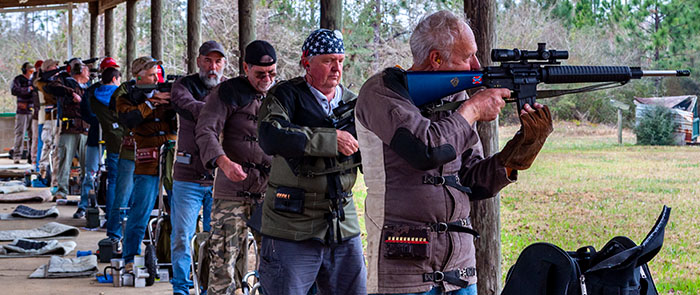
This stage is 20 minutes to fire 20 rounds for record. There is also a three minute preparation period. The PRPC match combines the time for prep and firing into a block time total of 23 minutes. This is done to help reduce time in the shooting coat, which is especially helpful in the summer heat. NRA questioned the block time practice in 2019 and approved of it's use.
The term "slow fire" means that each round is loaded one at a time. Consecutive rounds are not loaded into the magazine. After each round is fired, the rifle is empty and can be rested on the shooting stool. When ready to fire the next round, the rifle is pointed inside the range when the bolt is closed on the next round.
NRA RULE for Standing Position: 5.12 Standing—Erect on both feet, no other portion of the body touching
the ground or any supporting surface. The rifle will be supported by both
hands, the cheek and one shoulder and upper arm. The upper arm is defined
as from the middle of the bicep toward the shoulder. The elbow or back of the
forward arm may be placed against the body or rested on the hip. The sling
may not be used for support and may not be wrapped around the arm or hand.
The butt of the rifle must be on the outside of the coat.
NOTE - Discharging a firearm while resting the butt of the firearm on the top
of the shoulder is not allowed and may result in personal injury.
3. 200 Yards Rapid Fire from a Sitting or Kneeling Position
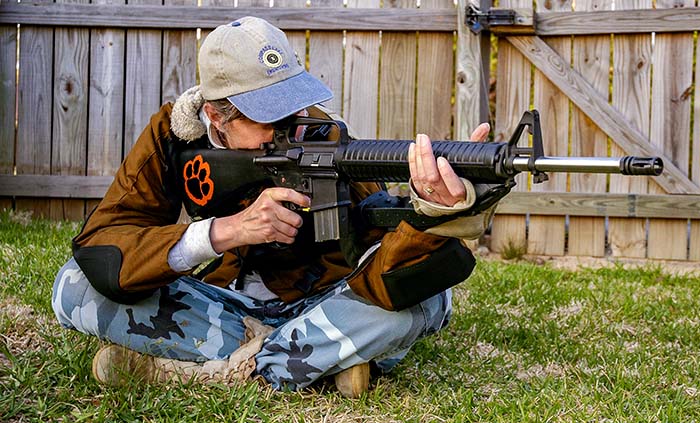
This is two strings of fire, each 10 rounds fired in a time limit of 60 seconds.
The stage begins with a three minute preparation period. During this time the competitor can remove the ECI and dry fire as they line up their sights to shoot the stage. No ammunition may be loaded into the rifle. At the end of the prep time, the rifle bolt is open and loaded magazines are beside the shooter-but not being held in their hand.
The sequence of fire for Service Rifle Category is two rounds then a magazine change. Then fire eight more rounds for a total of ten. A Match Rifle may fire five rounds, then reload and fire five additional rounds for a total of ten.
NRA RULE for Kneeling Position: 5.8 Kneeling—Buttocks clear of the ground, but may rest on one foot. The
rifle will be supported by both hands and one shoulder only. The arm supporting
the rifle must rest on the knee or leg. The elbow of the trigger arm will be free
from all support. One knee must be touching the ground. A roll as described
in Rule 3.14.1 may be placed under the instep provided the foot is placed
toe down at an angle not greater than 45 degrees from the vertical. Only the
trousers and underclothing may be worn between the shooter’s buttocks and
heel. The jacket or other article may not be placed between these two points.
If the kneeling roll is not used, the foot may be positioned at any angle, to
include placing the side of the foot and the lower leg in contact with the ground.
NRA RULE for Sitting Position: 5.10 Sitting—Weight of the body supported on the buttocks and the feet
or ankles, no other portion of the body touching the ground. The rifle will be
supported by both hands and one shoulder only. Arms may rest on the legs at
any point above the ankles.
4. 300 Yards Rapid Fire from the Prone Position (target reduced to simulate 300 yards)
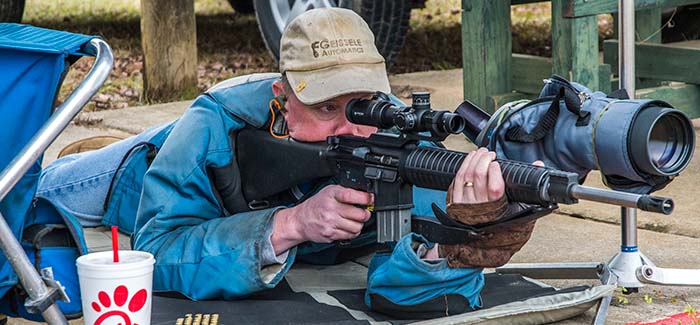
This is two strings of fire, each 10 rounds fired in a time limit of 70 seconds.
The stage begins with a three minute preparation period. During this time the competitor can remove the ECI and dry fire as they line up their sights to shoot the stage. No ammunition may be loaded into the rifle. At the end of the prep time, the rifle bolt is open and loaded magazines are beside the shooter-but not being held in their hand.
The sequence of fire for Service Rifle Category is two rounds then a magazine change. Then fire eight more rounds for a total of ten. A Match Rifle may fire five rounds, then reload and fire five additional rounds for a total of ten.
NRA RULE for Prone Position: 5.6 Prone—Body extended on the ground, head toward the target. The
rifle will be supported by both hands and one shoulder only. No portion of
the arms below the elbows shall rest upon the ground or any artificial support,
nor may any portion of the rifle or body rest against any artificial support. The
magazine may not compress the coat to the ground so as to provide artificial
support (see Rules 5.2 and 5.4).
5. 600 Yards Slow Fire from the Prone Position (target reduced to simulate 600 yards)
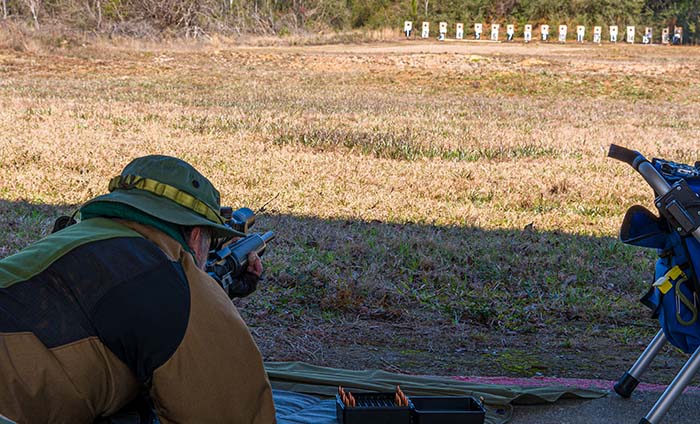
This stage is 20 minutes to fire 20 rounds for record. There is also a three minute preparation period. The PRPC match combines the time for prep and firing into a block time total of 23 minutes.
The term "slow fire" means that each round is loaded one at a time. Consecutive rounds are not loaded into the magazine. After each round is fired, the rifle is empty and can be rested on the shooting stool. When ready to fire the next round, the rifle is pointed inside the range when the bolt is closed on the next round.
Targets Used for the PRPC Match
NRA No. SR-5
Same scoring ring dimensions as No. SR Military with scoring rings through 7 only; paper size 28 x 28 inches. For use
at 200 yards on ranges with small target frames.
Aiming Black
X ring - 3.00 inches
10 ring - 7.00 inches
9 ring - 13.00 inches
Rings in White
8 ring - 19.00 inches
7 ring - 25.00 inches
NRA No. SR-42
Reduction of the SR-3 target to simulate the 300-
yard stage of the National Match Course at 200 yards.
Aiming Black
X ring - 3.00 inches
X ring - 1.90 inches
10 ring - 4.56 inches
9 ring - 8.56 inches
8 ring - 12.56 inches
Rings in White
7 ring - 16.56 inches
6 ring - 20.56 inches
5 ring - 24.56 inches
NRA No. MR-52
Reduction of the MR-1 target to simulate the
600-yard stage of the National Match Course at 200 yards.
Aiming Black
X ring - 3.00 inches
X ring - 1.79 inches
10 ring - 3.79 inches
9 ring - 5.79 inches
8 ring - 7.79 inches
7 ring - 11.79 inches
Rings in White
6 ring - 15.79 inches
5 ring - 19.79
Allowed Rifles Part 1: The Service Rifle
For the purposes of description, unless otherwise noted, the Civilan Marksmanship Program (CMP) definitions will be used to help the competitor be ready for requirements for Excellence In Competition (EIC) matches. The CMP Highpower Rifle Competition Rules 24th Edition - 2020 & 2021 are the source for this section.
The long term goal of the Service Rifle shooter is to earn the Distingquished Rifleman Badge.
1. The AR15 Type Rifle
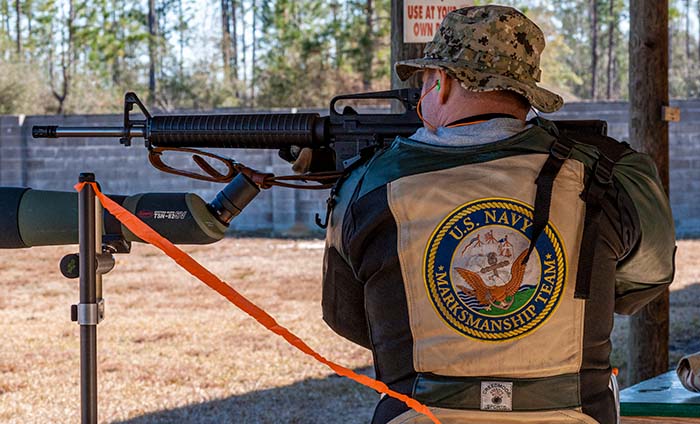
4.1.1 M16/AR15-Type Service Rifle.
The rifle must be an M16 U. S. Service
Rifle or a similar AR15-type commercial rifle that is derived from the M16
service rifle design. Rifles must exhibit the general overall external appearance
of the M-16 rifle or carbine. Visible barrel profiles, handguards or quad rails,
receivers, pistol grips, carry handles or rails and fixed or collapsible stocks
must appear essentially the same as the M16 service rifle and must incorporate
the following features; functional forward assist, integral case deflector,
functional ejection port cover, MIL-SPEC standard charging handle, and a
Picatinny rail located at standard MIL-SPEC height. The following specific rules
apply to this rifle:
a) Cartridge. Must be chambered for the 5.56 x 45 mm NATO (.223)
cartridge.
b) Action. Must be designed or modified so that only semi-automatic fire is
possible. The gas operating system must be fully operable and adhere to
the original M16 rifle design (i. e. Stoner design, gas impingement system)
or have a piston-operated gas system. Adjustable gas blocks are not
permitted. A gas block without a front sight is permitted. Left-handed
receivers that reverse the operational design features of M16/AR-type
rifles and with the ejection port opening upwards are permitted. An
extended bolt release is permitted on both right and left-handed receivers,
provided there are no permanent alterations to upper or lower receivers.
i) Relieved (Milled/Cut) lowers are allowed, but the use of an extended
bolt release that requires a relief in the receiver is not permitted.
Extended bolt releases must be attached on the original manufactured
side of the lower receiver.
ii) Billeted uppers and/or lower receivers are not permitted, provided that
lower receivers do not have integral trigger guards.
iii) Ambidextrous safeties, ambidextrous magazine releases and
ambidextrous charging handles are permitted, provided no permanent
alteration to the receiver was made to install them.
c) Barrel. Barrel length may not exceed the standard A2 barrel length of 20
inches, as measured from the bolt face to the end of the barrel. Flash suppressors are not required,
but if the barrel has a flash suppressor the
length of the barrel measured from the bolt face to the end of the flash
suppressor shall not exceed 21 ¼ inches. No full-length heavy barrels are
permitted. No portion of the barrel forward of the rearward location of the
gas block or front sight tenon shall have a diameter exceeding .750”.
Upper receivers and/or barrels may not be changed during the firing of any
event. Standard rifle length gas systems must be used for 20 inch barrels;
carbine length gas systems may be used for barrels less than 20 inches.
Barrels may not have compensators, muzzle brakes or sound
suppressors.
d) Trigger. Triggers may be either two-stage or single-stage. Triggers may
be adjustable, provided all adjustments are internal. Triggers must be of
standard curved design; trigger shoes are not permitted. The trigger pull
must be at least 4.5 pounds.
e) Handguard. The receiver and handguard must be machined as separate
parts. Standard M16-type service handguards (which may conceal a float
tube) may be used or military design or aftermarket free floating rail
systems may be used. The rail may be of one or multiple piece design and
be attached to the receiver by means of the rail itself or with a standard or
special barrel nut. Key-Mod, M-Lok or similar mounting systems are
permitted. Handguards may be of any length and the front sling swivel may
be attached to the hand guard, but any front sling swivel location must be
fixed 13 in. (+/- 0.5 in.) from the forward edge of the magazine well on M16
configured rifles or 8.0 in. (+/- 0.5 in.) on M4 configured rifles. Handguards
or float tubes may not have any additional features that could be used as
a hand stop.
f) Butt-Stocks. Butt-stocks may vary in length and be either fixed or
adjustable. Adjustable length butt-stocks may be changed during an event,
but butt-stocks that allow other adjustments such as the cheek-piece
height or butt-plate location are not permitted. Only standard A1 or A2 type
pistol grips are permitted.
g) Magazines. Metal or synthetic (polymer) magazines, standard issue or
commercial equivalent, straight or curved, must be attached during the
firing of all courses and in all positions. Allowable magazines must have
external dimensions that are similar to the standard service 20 or 30-round
box magazines, but may vary slightly in length and curvature, provided
they do not exceed 7 ¾ inches, from top to bottom, as measured along the
back of the spline. Magazines must not have any additional pads,
extensions or other support features. A 10-round magazine with external
dimensions at least as long as a standard service 20-round box magazine,
but not longer than a 30-round box magazine, may be used. A dummy
magazine with a ramp for single shot loading may be used if this magazine
has external dimensions at least as long as a standard service 20-round
box magazine, but not longer than a 30-round box magazine
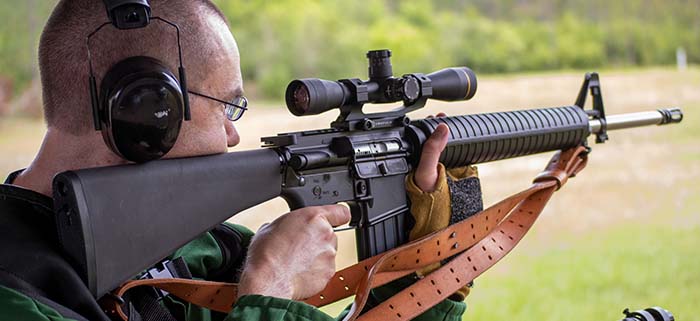
h) Optical Sights. The rifle may have an optical sight (reflective sights are
considered optical sights) with a maximum power of 4.5X installed on the
receiver. Variable scopes with a maximum of 4.5X are permitted. Only
commercially manufactured scopes that were produced with a maximum
magnification of 4.5X and have a maximum objective lens diameter of 34
mm may be used. If an optical sight is used, the same optical sight
configuration must be used in all stages of a course of fire (changing sights
or sight mount configurations is not permitted). The centerline of an optical
sight shall be no higher than 3.5 inches above the centerline of the bore.
i) Metallic Sights. Alternatively, the rifle may be equipped with an issue type
front sight assembly, removable front sight, or a collapsible front sight.
Metallic rear sights, if used, must have an M16 type sight design with the
rear sight in the carry handle. All metallic sights must utilize a front sight
post and have a maximum sight radius of 20.5 inches.
2. The M1A (M-14) Type Rifle
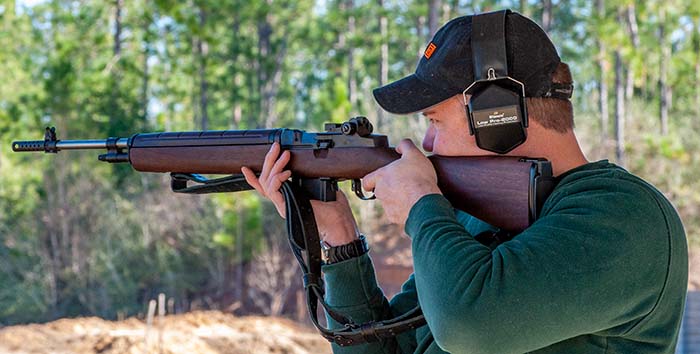
4.1.3 M14/M1A-Type Service Rifle
The rifle must be an M14/M1A-type rifle that was issued by the U.S. Armed
Forces, a Springfield Armory manufactured rifle or another commercial rifle of
the same type and caliber. The following specific rules apply:
a) The rifle must be chambered for the 7.62 mm NATO cartridge (.308
Winchester).
b) The rifle must have a trigger pull of at least 4.5 pounds.
c) No alteration or modification may change the external configuration of the
rifle, except that left-handed receivers that reverse the operational design
features of M14/M1A-type rifles are permitted.
d) Internal modifications may be made to improve functioning and accuracy.
A special match barrel may be installed. Synthetic materials may be
applied to the interior of the stock to improve the bedding.
e) No modification may interfere with the original functioning of the rifle and
its safety devices.
f) Rear sight windage and elevation adjustments may be modified to allow
finer adjustments.
g) Stock dimensions must comply with original stock dimensions, except that
stocks may be no more than 2 inches wide at a point immediately to the
rear of the front band, no more than 2.5 inches wide at the front and rear
of the receiver, and have a continuous taper from receiver to front band.
The width at the receiver may be carried through to the butt plate. If optical
sights are used, the attachment of a cheek pad or cheek-piece riser to the
butt-stock is permitted if the pad or attached cheek-piece is not
orthopedically shaped and is fixed so it cannot be moved or adjusted for
different firing positions.
h) The hinged butt plate may only be used in the folded position.
i) Stocks may have any color. Metals may have any finish. Metal
components may be either steel or aluminum alloy.
j) Magazine capacity may not exceed 20 rounds. All M14 or similar
commercial rifles must be used with full-length 10 or 20 round capacity
magazines. Magazines with a maximum capacity of 10 rounds may be
used, provided the length of the magazine box is the same as the standard
service 20-round magazine.
k) Vented barrel extensions with the same external dimensions as the M14
flash suppressor, but without the bayonet lug, may be installed. A muzzle
brake designed to reduce recoil is not permitted.
l) Optical Sights. The rifle may have an optical sight (reflective sights are
considered optical sights) with a maximum power of 4.5X installed on the
receiver. Variable scopes with a maximum of 4.5X are permitted. Only
commercially manufactured scopes that were produced with a maximum
magnification of 4.5X and have a maximum objective lens diameter of 34
mm may be used. If an optical sight is used, the same optical sight
configuration must be used in all stages of a course of fire (changing sights
or sight mount configurations is not permitted). The centerline of an optical
sight shall be no higher than 3.5 inches above the centerline of the bore.
m) Metallic Sights. Alternatively, the rifle may be equipped with standard
issue metallic sights. The dimensions of the rear sight aperture (internal
diameter) and the front sight post (width) may vary from standard military
dimensions. The rear sight hood diameter may not be longer than 0.70” or
larger than 0.50” in diameter. The rear sight aperture may have a fixed,
non-adjustable round, square or rectangular aperture insert. A corrective
lens or multi-focal lens system may be inserted in the rear sight hood.
3. The M1 Type Rifle
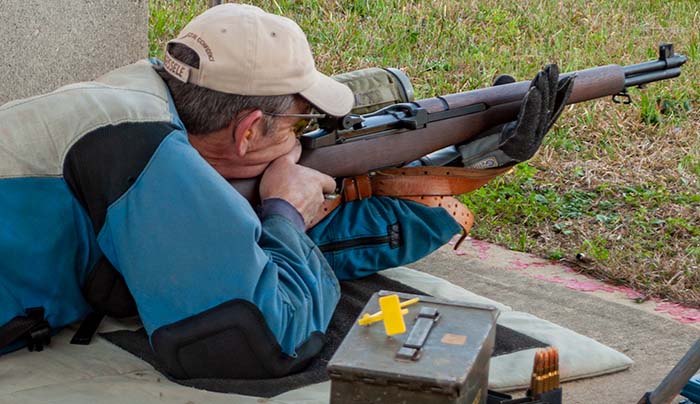
4.1.4 M1 Garand-Type Service Rifle
a) The rifle must be an M1 Garand rifle that was issued by the U.S. Armed
Forces or a commercial rifle of the same type and caliber. The following
specific rules apply to this type of rifle:
b) The rifle must be chambered for either the .30-06 or 7.62 mm NATO (.308
Win) cartridge.
c) No alteration or modification may change the external configuration of the
rifle, except as authorized in 4.1.4 j).
d) Internal modifications may be made to improve functioning and accuracy.
A special match barrel may be installed. Synthetic materials may be
applied to the interior of the stock to improve the bedding.
e) No modification may interfere with the original functioning of the rifle and
its safety devices.
f) The rifle must have a trigger pull of at least 4.5 pounds.
g) Rear sight windage and elevation adjustments may be modified to allow
finer adjustments.
h) The dimensions of the rear sight aperture (internal diameter) and the front
sight post (width) may vary from standard military dimensions. The rear
sight hood diameter may not be longer than 0.70” or larger than 0.50” in
diameter. The rear sight aperture may have a fixed, non-adjustable round,
square or rectangular aperture insert. A corrective lens or multi-focal lens
system may be inserted in the rear sight hood.
i) Optical Sights. The rifle may have an optical sight (reflective sights are
considered optical sights) with a maximum power of 4.5X installed on the
receiver. Variable scopes with a maximum of 4.5X are permitted. Only
commercially manufactured scopes that were produced with a maximum
magnification of 4.5X and have a maximum objective lens diameter of 34
mm may be used. If an optical sight is used, the same optical sight
configuration must be used in all stages of a course of fire (changing sights
or sight mount configurations is not permitted). The centerline of an optical
sight shall be no higher than 3.5 inches above the centerline of the bore.
j) Stock dimensions must comply with original stock dimensions. If optical
sights are used, the attachment of a cheek pad or cheek-piece riser to the
butt-stock is permitted if the pad or attached material is not orthopedically
shaped and is fixed so it cannot be moved or adjusted for different firing
positions.
NRA Additional Service Rifle, Not Allowed for CMP EIC Matches.
3.1 Service Rifle (d) - U.S. Rifle, Caliber 7.62 mm M-110 series (AR10)
In all courses of fire and
in all positions the standard 20-round box magazine or a reduced
capacity magazine of the same external dimensions will be attached.
The flash suppressor may be removed or the rifle may be manufactured
without a flash suppressor. Barrel length may not exceed 20 inches,
as measured to the end of the rifling in the barrel. The front sling
must be attached to the end of the handguard, and must remain in the
6 o’clock position no more than 1/2 inch from its original location.
Metallic sights must be of the standard design found on the M-16
series of firearms. Rear sight windage and elevation adjustments may
be modified to allow finer adjustments. Plastic covers may be used
on the mounting rails on the handguard.
Allowed Rifles Part 2: The Match Rifle?
The match rifle is a very open category with a wide variety of rifles and calibers. Listed in this section will first be the NRA definition of a match rifle and then the new for 2020 CMP definition. The specific rules will be copied from the current rule book.
NRA Rulebook: 3.3 NRA Match Rifle
A center fire rifle with any sights and a magazine
capable of holding not less than 5 rounds.
(a) See Rule 3.14, Palm Rest.
(b) A service rifle may be used as a match rifle unless otherwise stated
in the program. Any service rifle used as an NRA Match Rifle shall
conform to Rule 3.1 as applies to trigger pull.
(c) Semi-Automatic rifle. M-16 or commercially equivalent rifles, configured or customized as NRA Match Rifles are exempt from the 4 1/2
pound trigger weight requirement.
(d) Any semi-automatic rifle that has an original factory designed receiver/
frame in excess of 3 1/4 inches below the center line of the border
may be used as an NRA Match Rifle.
(e) Other Nations––A center fire rifle with metallic sights. This rifle must
meet the requirements to be a legal target rifle in the participant’s
home country, and may only be used by someone who is a foreign
national, and can provide evidence thereof. (It would be wise for a
foreign competitor to have a copy of his own country’s rifle rule, or
letter of certification from his National Association with him when
competing under this rule.)
CMP Rulebook: 4.1.5 CMP Match Rifle
A rifle that complies with this rule may be used in CMP sanctioned matches
when authorized by the match program. Match sponsors may divide
sanctioned match competitors into two categories for a) Service and Alternative
Rifles and b) Match Rifles.
a) Cartridge. May be chambered for any cartridge not exceeding .308” in
diameter and not less than .224” in diameter.
b) Action. May be semi-automatic or manually operated magazine-fed
repeater actions, except that match rifles used in prone only or Long
Range Matches (Rule 5.10) may be single shot rifles.
c) Barrel. Barrels may not have compensators, muzzle brakes or sound
suppressors.
d) Trigger. Unlimited, but rifles with triggers that will not remain cocked under
common competition conditions are not permitted.
e) Weight. Weight is unlimited.
f) Magazine. Must have a magazine capacity of not less than 5 rounds and
not more than twenty (20) rounds, except that rifles used in prone only or
Long Range Matches (Rule 5.10) may be single shot rifles and are not
required to have magazines. Magazines may be internal or detachable.
g) Sights. Sights may be metallic or optical. Optical sights may be of any
magnification, either fixed or variable. If the Match Program requires the
use of metallic (“iron”) sights for a specific event, only metallic sights may
be used when firing that event.
h) Accessories. Adjustable cheek-pieces and butt-plates are permitted.
Butt-plates may have a curved rear surface, but the depth of the curve, as
measured from a straight line from the top to the bottom of the butt-plate
may not exceed 0.5 inches. Hook butt-plates and palm-rests are
prohibited. Fore-end attachments (fore-end riser blocks) that do not
exceed 3.5 inches in depth from the centerline of the bore when attached
to the fore-end may be used in one or more positions or removed in one
or more positions. Fore-end attachments must have a flat (straight line)
surface without anatomical shaping (i.e. thumb or finger grooves, etc.).
Fore-end attachments may have a hand stop that can be used in the prone
and kneeling positions or an attachment device that are not included in
stock depth measurements (Rule 4.1.2 e).
Additional Rifle Specific Gear
NRA Rule Book: 3.7 Sights
(a) Metallic
(1) Non-corrective:
Any sighting system constructed of metal or equivalent which
provides a method of aiming by aligning 2 separate but visible
sights or reference points, mounted on the rifle, including tube
sights and non-magnifying filters.
(2) Corrective:
(Front Sight)—A lens and/or filter may be used in conjunction
with the front and/or rear sight.
(Rear Sight)— A corrective lens may be placed inside the rear
sight hood on service rifles conforming to Rule 3.1. No part of
the lens or method of installing the lens may protrude outside
the rear sight hood.
(b) Telescopic—Any sighting system which includes a lens or system of lenses and
an aiming reference or reticle at the focal plane of a lens or system
of lenses.
(c) Any—
Any sight without restriction as to material of construction.
Any sighting device programmed to activate the firing mechanism
is prohibited.
NRA Rule Book: 3.13 Slings
A sling may be a strap or straps made of leather, webbing, or
synthetic material, and hooks, buckles, and keepers as necessary for attachment to the rifle and adjustment to the shooter. Unless otherwise specified in
match conditions or position descriptions (Rule 5.12), the sling may be used
in connection with one arm to steady the rifle. A button, hook or strap may
be placed on the sleeve of the shooting coat to support the sling loop that is
placed on the upper arm.
(a) The sling need not be attached to the buttstock sling swivel in the
prone, sitting or kneeling positions. (See Rule 5.12 for standing
requirements)
(b) Service Rifle Slings - On service rifle slings, metallic wraps and other
type reinforcements to the sling keepers are not authorized. Standard
issue type leather or web slings may be no wider than 1.250” and no
thicker than .190”. Leather slings may have no more than two keepers
no wider than .860” each. Keeper ends may be joined by metallic
devices. The overlap at the joining area may be no more than 1.10”
and must be on the flat, i.e., may not go around the curved edge of
the keeper. Placement of cartridge cases, spindles, and so forth, to
tighten or lock the sling are not authorized. A button, hook or strap
may not be used on the sleeve of the shooting coat to support the
sling loop that is placed on the upper arm.
CMP Rule Book: 4.4 Rifle Slings
Slings may be used to provide support for the firing position in CMP-recognized
rifle events in accordance with these regulations:
4.4.1 Standard U. S. Military Slings
Slings used on all service rifles must be standard U. S. military issue M1907
leather, or M1 web slings or identical slings of commercial manufacture made
of leather, web or synthetic material.
4.4.2 Sling Configuration
Military issue or commercial M1907 and M1 slings must conform to the original
pattern with no modifications or additional hooks, claws, clips or clamps.
Leather or web slings may be no wider than 1 3/8 inches and no thicker than
3/16 inch. Leather slings may have no more than two keepers no wider than
7/8 inch each.
4.4.3 Sling Attachment
Slings must be attached directly to the front sling swivel; a sling hook may not
be used to attach a M1907 pattern or M1 sling to the front sling swivel. Quick
detachable sling swivels are permitted on the handguard/fore-end and/or
butt-stock.
4.4.4 Prohibited Sling Features
Competitors using Service Rifles (Rules 4.1.1, 4.1.3, 4.1.4) or Alternative Rifles
(Rule 4.1.2) may not use sling cuffs or padded or lined slings. The use of hooks,
buttons, straps or similar devices fastened to the shooting coat to hold the sling
in place is not permitted.
4.4.5 Match Rifle Slings
Competitors using Match Rifles (Rule 4.1.5) may wear shooting coats with
hooks, buttons or straps used to hold the sling in place. Slings used with Match
Rifles may be any type of sling with a maximum width of 3.5 inches.
4.4.6 How Slings Are Used
Slings must remain attached to Service or Alternative rifles in all positions when
they are being fired. M1907 or M1 slings may be configured with arm loops and
used for support in the prone, sitting or kneeling positions. In the standing
position, slings must remain attached at both the butt-stock and
handguard/fore-end of the rifle and may not be so tight as to support the back
of the hand or wrist. The sling may be included within the grip. The sling may be used to support the standing position only in the 200-yard stage of the
Infantry Team Match where the sling may be used as a hasty sling without
using an arm loop, but with the sling wrapped around the arm (Rule 5.8.3 b)).
In the sitting or kneeling and prone positions, the sling must be attached at the
forward sling swivel, but it does not have to remain attached at the rear sling
swivel.
Shooting Positions
First the techical description from the rule book.
CMP Rule Book: 5.1.1 Standing Position
The shooter must stand on both feet while supporting the rifle with both hands,
the shoulder or upper arm and the cheek. The arm that supports the rifle may
rest on the hip or side of the body. The other arm must grasp the rifle at the
pistol grip. The sling may be within the grasp of the left hand (right-handed
shooter) or it may pass over the outside of the hand, but it may not be used to
support the rifle. Some part of the rear surface of the butt-plate (toe of the buttplate) must contact the shoulder (shoulder pad on the jacket); the butt-stock
may not rest on top of the shoulder. The sling must remain attached to the rifle
in parade configuration when the Service or Alternative Rifle is used (see Rule
4.4.6). Slings are not required for Match Rifles or in CMP Games Matches.
CMP Rule Book: 5.1.2 Sitting or Kneeling Position
The shooter may elect to shoot in either the sitting or kneeling position. In the
sitting position, the shooter sits on the buttocks while supporting the rifle with
both hands, the shoulder and cheek. A sling may be used in either the sitting
or kneeling position. The legs may be crossed, extended or open. Both elbows
may rest on the legs that are extended or crossed in front of the shooter at any
point above the ankles. The elbows may not rest on the ground. In the kneeling
position, the shooter sits on one foot, which may be supported by a kneeling
roll, while supporting the rifle with both hands, the shoulder and cheek. If a
kneeling roll is used, the foot may not be turned at an angle of more than 45
degrees. One elbow may rest on the knee opposite the leg/foot on which the
shooter is sitting. No other part of the body or rifle may rest on any object or
support.
CMP Rule Book: 5.1.3 Prone Position
The shooter lies on the ground, with the head towards the target, with the rifle
supported by both hands, the shoulder and cheek. A sling may be used in the
prone position. The rifle may not touch the ground or rest on any object or
support. No part of the arm ahead of the elbow may touch the ground or any
artificial support. The magazine may touch the shooting jacket sleeve, but it
may not rest on the jacket sleeve, jacket elbow pad, arm or ground.
Rifle Match Gear
Vendors
Creedmoor Sports, Anniston, AL
Jim Owens' JarHeadTop.com, Enterprise, AL
Champion's Choice, LaVergne, TN
Turner Slings, Clay, AL
Shooting Coat
The shooting coat is not required, but is an allowed fitted piece of gear that when worn correctly can help enhance the repeatability of your shooting position. It has recoil and pulse pads and buckles that when adjusted properly can feel like an exoskeleton for support. This is especially true in the standing stage.
Shooting Glove or Mitt
The glove or mitt is not rquired, but is useful to protect the non-firing hand against the handguard and the leather sling. A great amount of pressure can be brought between the sling and handguard making this a helpful too. Some are a open finger mitt, full finger gloves and also fingerless gloves are used. There are no specific rule requirements for type of glove, just that it does not provide artificial support.
Mat or Ground Cover
A ground cover is useful for sitting and prone stages to provide comfort. It can be made of any material as long as it does not provide artificial support. Commercial mats will normally have non-skid surface areas built into it.
Spotting Scope or Telescope
This is located beside the shooter to watch the wind speed by viewing the mirage. It is also useful for checking the score at the target. The most useful shape is a scope with a 45 degree eyepiece which helps keep the scope from being moved during shooting. A wide variety of zoom is available, but 26X scope will be plenty do perform the task.
When new, many shooters will use whatever they have to spot their shots. At PRPC wind is usually not an issue, so the scope is mostly for seeing shots on target during firing.
When ready to purchase a scope, this is an investment. Also what is known as "buy once, cry once" because of the wide variety of glass and scope quality such as how it handles light, clarity and how it handles in any weather condition. The match director's personal preference is KOWA brand. He's been using the same KOWA for about 20 years with no issues.
The spotting scope stand decision is almost (or just) as important as the stand that supports the scope. The best stand is one that requires the fewest hand movements to make adjustments. The Ray-Vin stand is the best in the opinion of the match director. Ray has retired so it may be possible to find a used stand on the secondary market. Other stand options are in the vendor links above.
Shooting Stool/Cart
The rules allow a kit that does not interfere with adjacent shooters or act as a wind break. This takes the form of a stool that has a built in bag, usually with zipper pockets, that holds gear like the magazines, ammo, mitt, etc.
NRA Rule: 3.9 Shooting Kits
The shooting kit or stool may not be of such size and
construction as to interfere with shooters on adjacent firing points or to constitute
a wind break. (Use of a rifle rest forward of the forward shoulder is prohibited
except in the prone position for resting the rifle between shots.
CMP Rule: 4.5.7 Shooting Kits or Stools
A shooting kit, stool, or cart may be used to carry equipment. The kit, stool or
cart may be placed on the firing point, but may not be located forward of the
firing line. The kit or stool may not be of such size or construction as to
constitute a windbreak.
Rifle Sling
The rifle sling is an essential part of the shooting experience. The sling provides the support for the rifle when in prone and sitting position and does all the work holding the rifle. If the shooter is holding (muscling) the rifle, poor shots will result, especially at longer distances.
When used properly, the sling will provide a rock steady hold. The match director has found that his sling supported postion from prone is a much more stable rest than shooting from the bench.
NRA Rule 3.13 Slings
A sling may be a strap or straps made of leather, webbing, or
synthetic material, and hooks, buckles, and keepers as necessary for attachment to the rifle and adjustment to the shooter. Unless otherwise specified in
match conditions or position descriptions (Rule 5.12), the sling may be used
in connection with one arm to steady the rifle. A button, hook or strap may
be placed on the sleeve of the shooting coat to support the sling loop that is
placed on the upper arm.
(a) The sling need not be attached to the buttstock sling swivel in the
prone, sitting or kneeling positions. (See Rule 5.12 for standing
requirements)
(b) Service Rifle Slings - On service rifle slings, metallic wraps and other
type reinforcements to the sling keepers are not authorized. Standard
issue type leather or web slings may be no wider than 1.250” and no
thicker than .190”. Leather slings may have no more than two keepers
no wider than .860” each. Keeper ends may be joined by metallic
devices. The overlap at the joining area may be no more than 1.10”
and must be on the flat, i.e., may not go around the curved edge of
the keeper. Placement of cartridge cases, spindles, and so forth, to
tighten or lock the sling are not authorized. A button, hook or strap
may not be used on the sleeve of the shooting coat to support the
sling loop that is placed on the upper arm.
Return to Home Page




